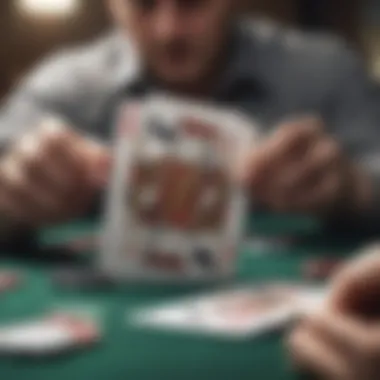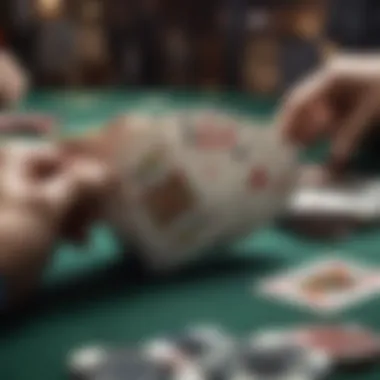The Value of Poker Cards: An In-Depth Exploration


Intro
Poker cards have a value that extends far beyond the felt at the casino tables. Their significance can be seen in a multitude of contexts—from the strategies employed by players to their economic impact on the broader gambling industry. The aim of this analysis is to explore all angles related to poker cards, shedding light on their worth through various lenses.
The intricacies of poker strategies can vary widely, impacting how players perceive and utilize the cards in their hands. Additionally, a glance at the historical evolution of these cards reveals fascinating narratives that have shaped the game as we know it today.
In discussing the psychological implications of card values, it becomes clear how mental acuity and strategic foresight are paramount in both casual and competitive gaming environments. These factors intertwine with the intrinsic values attributed to specific cards, affecting both player performance and the outcome of games.
Overall, understanding the value of poker cards is not just about game mechanics— it is about grasping the very essence of poker itself, which serves as a reflection of strategy, economics, and human psychology.
Understanding Poker Cards
Poker cards hold a central place in the gaming world, serving not only as instruments of play but also as symbols of strategy and culture. This article seeks to uncover the layers of importance these cards possess, guiding readers through their historic and modern relevance. The deeper we understand poker cards, the more equipped we become to appreciate the subtleties of gameplay, the significance of card values, and the strategic implications of betting dynamics.
The Evolution of Playing Cards
The story of playing cards dates back centuries, with their roots traced to ancient China and India before gradually making their way to Europe in the 14th century. Each geographic region brought its unique spin to card design and usage. In Europe, cards evolved into four suits—hearts, diamonds, clubs, and spades—each reflecting societal norms and values.
While originally, cards served primarily as entertainment, they quickly became intertwined with gambling, highlighting the risks and rewards associated with play.
This evolution is more than a recounting of history; it’s about understanding how cultural shifts have influenced the way we perceive and utilize these cards in poker today.
Basic Structure of Poker Cards
Poker cards are comprised of a standardized design that not only provides enjoyment but also establishes a framework for the game. Knowing this structure is vital for any player aiming to master the art of poker.
Suits and Ranks
At the heart of every poker game lies the concept of suits and ranks. Each suit—hearts, diamonds, clubs, spades—has specific attributes and importance in various poker variations. The ranks, from two up to ace, determine the hierarchy within each suit.
What makes this characteristic essential is its ability to drive decision-making processes during gameplay. Players often weigh their options based on the strength of their hand, which is influenced heavily by the distribution of suits and ranks.
In many respects, the beauty of poker comes from the strategic depth embedded in these simple classifications. Pairs, flushes, and straights all hinge on this fundamental order.
The Role of Jokers
Jokers are an interesting twist in the realm of poker cards. In games where they are included, jokers can function as wild cards, providing flexibility in hand formation. Their presence injects unpredictability into the game, sometimes acting as game changers.
However, not all poker varieties consider jokers necessary or advantageous. This duality sets the stage for varying play styles and strategies. The inclusion of jokers may lead to a more casual or unconventional approach to play, allowing players to embrace creativity and improvisation.
Their unpredictable nature can be seen as both an advantage for those willing to take risks and a disadvantage for traditionalists who prefer a more stringent structure in gameplay.
“Understanding the underlying structure of poker cards can significantly enhance your game, transforming mere luck into deliberate strategy.”
Thus, each layer of poker cards—not just their appearance or their basic functions—unveils a wealth of knowledge crucial to any player looking to excel in the competitive world of poker.
Intrinsic Value of Poker Cards
The intrinsic value of poker cards is a pivotal topic in understanding their overall significance in both casual and competitive gaming settings. At the heart of poker lies a system of value that transcends the mere physical characteristics of the cards themselves. This value can often define player strategies, shape game dynamics, and influence the decisions made on the felt.
When we refer to intrinsic value, we're talking about the worth of a card based on its role and contribution to the game, rather than its monetary cost or physical condition. Every card has a purpose; whether in creating combinations, altering the odds in a hand, or guiding the psychological plays between opponents, understanding this intrinsic value can enhance a player's overall experience and success.
Card Ranks and Game Mechanics
High Cards
High cards hold a special place in most poker games. These cards, typically the face cards and aces, often dictate the strength and potential of a player's hand.
What makes high cards appealing is their ability to form powerful combinations or stand alone as a strong hand. For instance, an ace can lead to top pairs or high flushes, while face cards can easily create strong straights. This potential can be a game-changer, providing players with a solid foundation for betting or bluffing.
A unique feature of high cards is their psychological impact. Successfully playing a high card can not only boost a player's hand but also intimidate opponents at the table. However, there is a disadvantage: players can become too reliant on high cards and fail to recognize when it’s time to fold, leading to unnecessary losses.


Low Cards
In contrast, low cards also contribute uniquely to poker dynamics. Low-value cards, such as 2s through 5s, may seem less influential at first glance, but they can create certain advantageous situations. For instance, in games like Lowball, players aim for the worst hand possible, making low cards essential. Additionally, low cards are often utilized to complete straights or sets in other games where their utility can be maximized.
A key characteristic of low cards is their ability to engage in deceptive strategies. Opponents may underestimate their potential, leading to surprise wins. The challenge, however, lies in the shallow value of these cards, as they’re likely to hold less weight in most traditional poker formats. Thus, the player’s skill in navigating their use becomes increasingly important.
Suit Importance in Game Dynamics
Flushes
Flushes represent a significant strategic component within poker, fundamentally altering how players approach hands. A flush occurs when a player holds five cards of the same suit, regardless of their rank. This combination not only signals strength but also raises the stakes during betting rounds.
Flushes are beneficial because they stand out in showdowns, often outmatching simpler combinations like pairs or two pairs. This advantage is rooted in the difficulty of achieving such a hand, making it a profitable asset. However, flushes can also impose an important consideration for players: a flush can be beaten by a full house or straight flush. Therefore, recognizing the risk and reward of playing into flushes is crucial.
Suit Interactions
Suit interactions can be described as the collective behavior of card suits throughout a hand. Understanding these dynamics is essential for formulating effective strategies, especially when considering how suits can interact with each other. A relevant aspect here is the way suits can cancel or enhance the functions of high or low cards. For example, if a player holds two hearts and one spade, the potential for flushes can create complex betting scenarios among opponents.
This unique feature plays a pivotal role in competition, as recognizing suited connections allows players to adjust their strategies on the fly. However, overestimating suit interactions can lead to misreads of the table dynamics, potentially clouding judgment during critical decisions. Thus, being astute about these interactions can greatly influence success at the poker table.
"In poker, the cards you play, and the cards you don't play, define your ultimate success. Understanding the intrinsic value helps navigate this complex landscape."
Ultimately, appreciating the intrinsic value of poker cards—as seen through their ranks, suits, and the interplay between them—can turn a novice into a formidable opponent. By fostering an in-depth understanding of these elements, players can craft more informed strategies and maintain an edge in both informal games and high-stakes tournaments.
Perceived Value in Diverse Contexts
Understanding the perceived value of poker cards transcends mere gameplay. It serves as a window into how players interact with the game and the cards themselves. This value doesn't solely hinge on card utility; it’s intertwined with personal experiences, cultural significance, and psychological factors that players may often overlook. Whether it’s the thrill of a winning hand or the nostalgia associated with a favorite deck, these elements contribute significantly to how both casual players and seasoned pros perceive their cards.
Psychology of Card Value
Risk Perception
Risk perception plays a crucial role in determining how players view the value of their poker cards. When a player assesses their hand strength, they will subconsciously weigh the potential risks they face against the opportunity to win. This subjective evaluation can greatly influence decision-making during gameplay, especially in high-stakes situations.
The thrill of wagering large sums comes with an emotional price tag. Genevieve, a local poker enthusiast, once remarked, "My best moments are when I push all in with that under-pair. It’s a gamble, sure, but the adrenaline change gives everything a deeper taste."
With risk perception, a card regarded as weak may suddenly become valuable if it leads to a significant payoff. This psychological aspect makes risk perception a beneficial characteristic for understanding player behaviors and motivations. However, it can also lead to unfortunate decisions fueled by too much confidence or miscalculated assessment of the table’s dynamics.
Anticipated Outcomes
Anticipated outcomes further enhance the discussion around perceived value. Players often think ahead, envisioning not just how their hand will play out but also how their opponents might react. Such foresight shapes not only their strategies but also their emotional investment in the game.
Imagine a scenario where a player holds a modest hand but believes that others perceive their strength as more formidable. This anticipation can lead to a situational bluff, vastly modifying the card's value in their mind. The expectation to win or lose can cause tempers to flare or composure to remain steady. This psychological layer is instrumental in building strategies, further entrenching the concept of perceived value within the game. Yet, overly positive expectations can lead to missteps, shattering confidence rather than boosting it.
Cultural and Historical Significance
Cards in Literature
When probing the cultural significance of poker cards, literature serves as a time-honored backdrop. The depiction of cards—representing chance, fate, and human cunning—offers insights beyond mere gameplay. Writers often weave poker narratives as metaphors for life’s complexities.


For example, in The Great Gatsby, the poker games reflect the larger American dream, symbolizing both opportunity and deceit. This literary connection elevates poker cards beyond simple gaming tools, infusing them with themes of risk, ambition, and morality. As Jacob, an avid reader, stated, "Every poker scene I read pulls me into deep reflections about choices and consequences."
Cards in literature enhance their perceived value, making the act of playing more than just about winning or losing. Readers glean insights, sharpening the multilayered meanings behind every hand. Yet, this connection also risks romanticizing card games, neglecting their sometimes ruthless nature.
Symbolism in Art
The symbolism of poker cards in art further exemplifies their nuanced standing in culture. Artists frequently harness card imagery to convey deeper meanings—wealth, fate, or even the themes of chance vs. skill. The works of Paul C�ézanne or Henri Matisse, for instance, showcase cards not merely as game pieces but as vehicles for personal narrative.
Allusion to cards in visual art challenges viewers to contemplate the intersection of luck and decision. This crossover enhances their perceived significance. As Linda, a gallery curator, often explains to visitors, "Cards signify much more than a game; they encapsulate life's unpredictability, bridging the gap between chaos and structure."
However, this symbolic weight can be a double-edged sword. While it elevates poker cards artistically, it may also mislead participants into overlooking the game’s competitive nature.
In sum, the perceived value of poker cards in diverse contexts encompasses psychological intricacies and cultural depths, intertwining them with human motivations and thoughts far beyond the poker table.
Strategic Implications of Card Values
Understanding strategic implications in poker is essential for anyone looking to improve their game. It's not just about the cards you have; it's about how you perceive those cards within the context of the entire game. This section speaks to the crucial role that card values play in shaping player decisions, influencing outcomes, and ultimately determining success. Developing a sound strategy hinges on grasping these nuances and adapting accordingly to the shifting landscape of a poker table.
Developing Winning Strategies
Hand Reading Techniques
Hand reading is a technique that poker players use to determine what cards their opponents might have based on their behaviors and betting patterns. A key characteristic of effective hand reading is its reliance on keen observation. Players successful in this area often pay attention not only to bets but also to players' physical tells, and timing, which can provide hints about an opponent’s hand strength.
This ability to evaluate what others might hold can be incredibly advantageous. It allows a player to make better-informed decisions, whether that means deciding to raise, call, or fold. The challenge lies in its subjective nature. What one player perceives as a strong tell may be interpreted differently by another. Also, while skilled players can become adept at hand reading, it requires constant practice, and there’s always a risk of overanalyzing or misinterpreting cues.
The advantage here is clear; fine-tuning your hand reading can elevate a player from average to exceptional.
Bluffing and Deception
Bluffing is an art form in poker, involving the strategic presentation of false strength to mislead opponents. This tactic plays a significant role in manipulating opponents' perceptions and driving them to make errors. A hallmark of effective bluffing is timing. Knowing when to bluff can dramatically shift the game's momentum in one's favor. Bluffing can become a popular choice among strategic players, especially when they want to induce folds from stronger hands or create a narrative about their play.
However, it's essential to balance bluffs with genuine strong hands. Relying too heavily on deception can backfire; astute opponents will catch on. Successful bluffing requires reading the table and having a good understanding of your opponents’ tendencies. Thus, while bluffing can yield considerable gains, it presents risks and necessitates sound judgment.
Card Value and Betting Dynamics
Bet Sizing
Bet sizing refers to the size of the wager a player makes during a hand and is critical in influencing how opponents might react. Adjusting bet sizes can act as a tool for controlling the flow of the game. For instance, making a larger bet with a strong hand can pressure opponents into making tough decisions, while a smaller bet may appear more inviting for players with weaker holdings.
A key characteristic of bet sizing is its versatility. Skilled players adapt their bet sizes based on table dynamics, chip stack sizes, and the tendencies of opponents, making it a flexible choice. The drawback? It can also expose players when they consistently bet a certain way based on their strength. Variation in bet sizes, therefore, is essential to keeping opponents guessing and off balance.
Pot Odds
Pot odds represent the ratio of the current size of the pot to the size of the bet you must call. Understanding pot odds helps players make calculated decisions about whether to continue in a hand. A vital part of this concept is its mathematical nature; players can quantify the value of their shot at a specific hand versus the risk present in calling a bet.
Why are pot odds a beneficial concept? They offer clarity and structure in decision-making, allowing a player to assess whether the potential reward justifies the cost of continuing through a hand. However, like many strategies, it has its downsides. New players may find it challenging to accurately calculate pot odds under pressure, especially in fast-paced environments. Thus, while understanding pot odds can significantly improve one’s strategic approach, mastery requires practice and experience.
"In poker, the depth of strategy lies not only in one's hand but also in understanding the interplay of action and reaction around the table."


By incorporating these tactical elements, poker players can better navigate the complexities of the game, enhancing their overall experience and success.
Economic Considerations in Poker
The role of poker cards extends beyond the game itself; it has significant economic implications that reflect the dynamics of the gambling industry. Understanding these considerations is crucial for dive into the myriad factors that influence how poker cards are valued, from collectibles to their impact on modern gaming practices.
Recognizing the factors interplays between economics and poker helps gamers and investors alike grasp the potential for profit or loss associated with card games and how that plays a role in broader economic trends.
Market Value of Poker Cards
Collectible Cards
Collectible cards hold a special place in the world of poker, often offering a unique value proposition that goes beyond their functional use in games. These can range from vintage decks that are steeped in history to tournament-specific cards. There is a tangible allure in owning something rare; collectors often go to great lengths to acquire cards that have significance.
The primary allure of collectible cards lies in their scarcity. A limited edition card can fetch astronomical prices, providing both emotional and financial benefits. Despite their cost, these cards fit well into this analysis as they shed light on the very fabric of poker's economic landscape. The challenge comes in how to establish authenticity and condition, which can significantly impact value.
Value Determinants
Several factors influence the value of poker cards, including rarity, condition, and market demand. Understanding what makes a card valuable can clarify why certain cards are highly sought after while others gather dust. A card in pristine condition can command a premium price; however, even slight imperfections can lead to drastic reductions in value.
Another important aspect is the historical context of a card. Some cards carry stories that resonate with players, further elevating their desirability. This intertwining of history and value makes for a compelling narrative that can enhance player engagement but can also complicate market dynamics.
Impact on the Gambling Industry
Casual vs. Professional Play
The distinctions between casual and professional play provide fertile ground for examining economic impact in poker. Casual players might purchase a standard deck for home games, while professional players often seek out specialized cards or premium decks that enhance their experience and strategically influence their opponents. This difference reflects a broader economic landscape where leisure spending varies significantly.
Understanding this dichotomy helps in a comprehensive evaluation of how poker supplies contribute to different facets of society, influencing everything from local economies to international markets.
Growth of Online Poker
The rise of online poker represents a transformative chapter in the gambling industry. As virtual platforms continue to gain traction, the demand for digital card games increases, shifting the economic landscape of poker. This shift allows players worldwide to participate in games without the geographical constraints of traditional casinos. In turn, it heightens competition and diversifies the market.
As more players explore online options, the economic implications are profound. It opens avenues for revenue streams that extend beyond just card sales. Understanding the growth of online poker is critical to discerning how poker cards fit into this evolving narrative of gambling. > "The intersection of cards and economy in poker invites players into a realm where strategy meets financial savvy."
Overall, analyzing these economic considerations offers a comprehensive view of poker not merely as a game but as a vibrant component of economic activity.
Closure
Understanding the value of poker cards goes beyond just grasping their intrinsic worth or perceived significance within the gaming world. It ties together a myriad of factors, from game strategy and historical evolution to psychological aspects and economic implications. This concluding section draws together the various threads discussed throughout the article to highlight the overarching importance of poker cards across different contexts.
Summing Up the Value of Poker Cards
At the crux of this exploration lies the dual aspect of card values — intrinsic and perceived. Intrinsic value reflects the actual utility of the card in gameplay, determined by its rank or suit. On the other hand, perceived value hinges on players' emotions, beliefs, and expectations regarding potential outcomes in games.
Final Thoughts on Intrinsic and Perceived Value
The intrinsic value of poker cards is measurable and quantifiable, largely defined by game mechanics. A high-ranking card in a game of Texas Hold'em can deliver tangible advantages, making it a critical component of strategic play. Conversely, the perceived value is more subjective. A card that one player may view as a potential winning hand might not hold the same weight in the eyes of another. This variability allows for fascinating discussions about psychology and risk perception in gaming.
The key characteristic of these differing values is their ability to shape player behavior and influence decisions at the table. Players often weigh expected outcomes against their risk appetite, determining how much they are willing to stake based on both intrinsic value and their own perceptions of what that value signifies.
Moreover, examining the balance between intrinsic and perceived values provides insight into the broader implications for casual and professional play alike. Each card dealt carries with it not just numbers and suits but a story influenced by individual experiences and historical contexts.
"In poker, as in life, the value assigned to anything often depends more on perception than reality."
This discussion reinforces why understanding card values is fundamental for not just hobbyists but also seasoned players seeking to refine their strategies and enhance their performance. By acknowledging the advantages of grasping both intrinsic and perceived values, players can capitalize on their insights to make informed decisions during games, adapting their plays to encompass a more holistic understanding of both aspects. Ultimately, knowing the depth of value inherent within poker cards can greatly elevate the gaming experience and enhance the connection players have with the game itself.







